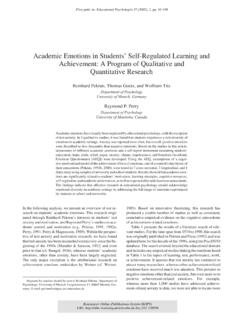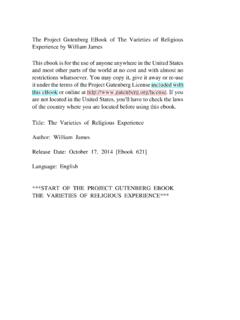Transcription of Culture and the Self. Implications for Cognition, Emotion ...
1 Psychological Review Copyright 1991 by the American Psychological Association~ Inc. 1991, Vol. 98, No. 2, 224-253 0033-295X/91/$ Culture and the Self." Implications for Cognition, Emotion , and Motivation Hazel Rose Markus Shinobu Kitayama University of Michigan University o f Oregon People in different cultures have strikingly different construals of the self, of others, and of the interdependence of the 2. These construals can influence, and in many cases determine, the very nature of individual experience, including cognition, Emotion , and motivation. Many Asian cul- tures have distinct conceptions of individuality that insist on the fundamental relatedness of indi- viduals to each other. The emphasis is on attending to others, fitting in, and harmonious interde- pendence with them. American cuRure neither assumes nor values such an overt connectedness among individuals.
2 In contrast, individuals seek to maintain their independence from others by attending to the self and by discovering and expressing their unique inner attributes. As proposed herein, these construals are even more powerful than previously imagined. Theories of the self from both psychology and anthropology are integrated to define in detail the difference between a construal of the self as independent and a construal of the self as interdependent. Each of these divergent construals should have a set o fspecific consequences for cognition, Emotion , and motiva- tion; these consequences are proposed and relevant empirical literature is reviewed. Focusing on differences in self-construals enables apparently inconsistent empirical findings to be reconciled, and raises questions about what have been thought to be Culture -free aspects of cognition, Emotion , and motivation.
3 In America, "the squeaky wheel gets the grease: In Japan, the importance o f harmonious interdependence with them. "the nail that stands out gets pounded downy American par- These construals of the self and others are tied to the implicit, ents who are trying to induce their children to eat their suppers normative tasks that various cultures hold for what people are fond o f saying "think of the starving kids in Ethiopia, and should be doing in their lives (cf. Cantor & Kihlstrom, 1987;. appreciate how lucky you are to be different from t h e m " Japa- Erikson, 1950; Veroff, 1983). Anthropologists and psycholo- nese parents are likely to say "Think about the farmer who gists assume that such construals can influence, and in many worked so hard to produce this rice for you; if you don't eat it, cases determine, the very nature o f individual experience (Cho- he will feel bad, for his efforts will have been in vain" (H.))
4 Ya- dorow, 1978; Dumont, 1970; Geertz, 1975; Gergen, 1968; Gilli- mada, February 16,1989). A small Texas corporation seeking to gan, 1982; Holland & Quinn, 1987; Lykes, 1985; Marsella, De elevate productivity told its employees to look in the mirror and Vos, & Hsu, 1985; Sampson, 1985, 1988, 1989; Shweder & Le- say "I am beautiful" 100 times before coming to work each day. Vine, 1984; Smith, 1985; Triandis, 1989; Weisz, Rothbaum, &. Employees of a Japanese supermarket that was recently opened Blackburn, 1984; White & Kirkpatrick, 1985). in New Jersey were instructed to begin the day by holding Despite the growing body of psychological and anthropolog- hands and telling each other that "he" or "she is beautiful" ('9, ical evidence that people hold divergent views about the self, Japanese Supermarket," 1989). most of what psychologists currently know about human na- Such anecdotes suggest that people in Japan and America ture is based on one particular view--the so-called Western may hold strikingly divergent construals of the self, others, and view of the individual as an independent, self-contained, au- the interdependence of the two.
5 The American examples stress tonomous entity who (a) comprises a unique configuration of attending to the self, the appreciation of one's difference from internal attributes ( , traits, abilities, motives, and values) and others, and the importance of asserting the self. The Japanese (b) behaves primarily as a consequence of these internal attri- examples emphasize attending to and fitting in with others and butes (Geertz, 1975; Sampson, 1988, 1989; Shweder & LeVine, 1984). As a result o f this monocultural approach to the self(see Kennedy, Scheier, & Rogers, 1984), psychologists' understand- Many thanks to Hiroko Akiyama, Nancy Cantor, Steve Cousins, ing of those phenomena that are linked in one way or another to Susan Cross, Alan Fiske, Carol Gilligan, Tom Givon, Lawrence the self may be unnecessarily restricted (for some important Hirschfeld, Chic Kanagawa, John Kihlstrom, Joan Miller, Richard exceptions, see Bond, 1986,1988; Cousins, 1989; Fiske, in press.)
6 Nisbett, Jeanne Oggins, Richard Shweder, Mark Snyder, Harry Trian- Maehr & Nicholls, 1980; Stevenson, Azuma, & Hakuta, 1986;. dis, Hiroko Yamada, and Robert Zajonc for their extremely helpful Triandis, 1989; Triandis, Bontempo, Villareal, Asai, & Lucca, comments on earlier versions of this article, and thanks to Debbie 1988). In this article, we suggest that construals of the self, of Apsley for preparing the manuscript. Correspondence concerning this article should be addressed to Ha- others, and of the relationship between the self and others may zel Rose Markus, Research Center for Group Dynamics--ISR, Univer- be even more powerful than previously suggested and that their sity of Michigan, Ann Arbor, Michigan 48106-1248, or to Shinobu influence is clearly reflected in differences among cultures. In Kitayama, Department of Psychology, University of Oregon, Eugene, particular, we compare an independent view o f the self with one Oregon 97403-1227.
7 Other, very different view, an interdependent view. The indepen- 224. Culture AND THE SELF 225. dent view is most clearly exemplified in some sizable segment Moreover, we realize that there may well be important of American Culture , as well as in many Western European distinctions among those views we discuss as similar and that cultures. The interdependent view is exemplified in Japanese there may be views of the self and others that cannot easily be Culture as well as in other Asian cultures. But it is also character- classified as either independent or interdependent. istic of African cultures, Latin-American cultures, and many Our intention is not to catalog all types ofself-construals, but southern European cultures. We delineate how these divergent rather to highlight a view of the self that is often assumed to be views of the self--the independent and the interdependent-- universal but that may be quite specific to some segments of can have a systematic influence on various aspects o f cognition, Western Culture .
8 We argue that self-construals play a major role Emotion , and motivation. in regulating various psychological processes. Understanding We suggest that for many cultures of the world, the Western the nature of divergent self-construals has two important conse- notion o f the self as an entity containing significant disposi- quences. On the one hand, it allows us to organize several appar- tional attributes, and as detached from context, is simply not an ently inconsistent empirical findings and to pose questions adequate description o f self hood. Rather, in many construals, about the universality assumed for many aspects o f cognition, the self is viewed as interdependentwith the surrounding con- Emotion , and motivation (see Shweder, 1990). On the other text, and it is the "other" or the "self-in-relation-to-other" that is hand, it permits us to better specify the precise role o f the self in focal in individual experience.
9 One general consequence o f this mediating and regulating behavior. divergence in self-construal is that when psychological pro- cesses ( , cognition, Emotion , and motivation) explicitly, or T h e Self: A D e l i c a t e C a t e g o r y even quite implicitly, implicate the self as a target or as a refer- ent, the nature of these processes will vary according to the Universal Aspects of the Self exact form or organization of self inherent in a given construal. In exploring the possibility o f different types o f self-con- With respect to cognition, for example, for those with interde- struals, we begin with Hallowell's (1955) notion that people pendent selves, in contrast to those with independent selves, everywhere are likely to develop an understanding of them- some aspects of knowledge representation and some of the pro- selves as physically distinct and separable from others.
10 Head cesses involved in social and nonsocial thinking alike are in- (1920), for example, claimed the existence o f a universal fluenced by a pervasive attentiveness to the relevant others in schema of the body that provided one with an anchor in time the social context. Thus, one's actions are more likely to be seen and space. Similarly, Allport (1937) suggested that there must as situationally bound, and characterizations of the individual exist an aspect of personality that allows one, when awakening will include this context. Furthermore, for those with interde- each morning, to be sure that he or she is the same person who pendent construals of the self, both the expression and the expe- went to sleep the night before. Most recently, Neisser (1988). rience of emotions and motives may be significantly shaped and referred to this aspect of self as the ecologicalself, which he governed by a consideration o f the reactions of others.


















